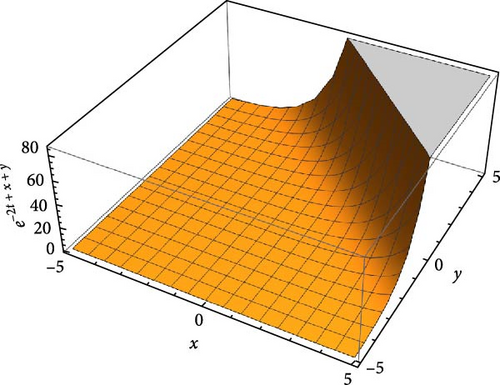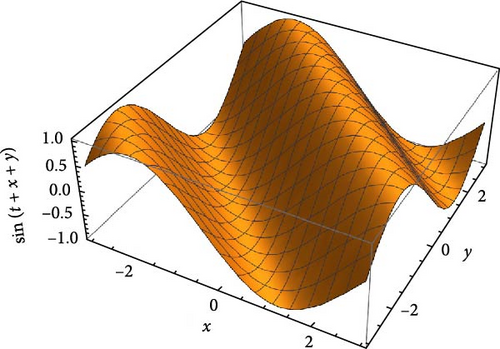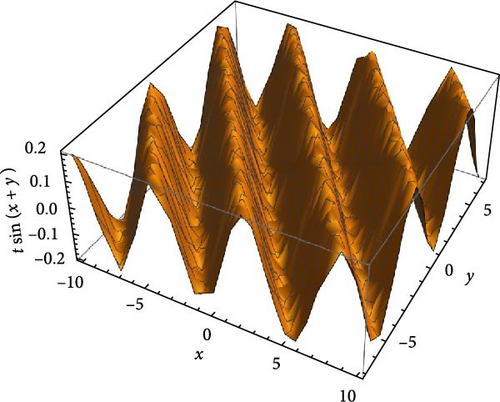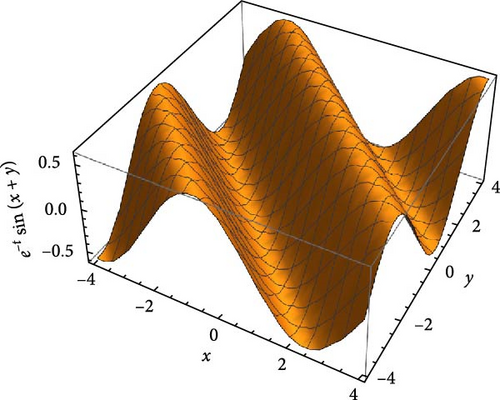Analytical Treatments for a Coupled (2+1)-Dimensional Partial Differential Equations in Nonlinear Physics
Abstract
The two-dimensional (2D) nonlinear coupled sine-Gordon equations play a significant role in nonlinear physics, describing phenomena in areas such as solid-state physics, fluid dynamics, and nonlinear optics. Fundamentally, the sine-Gordon equation is a nonlinear partial differential equation (PDE) commonly used to model wave propagation, soliton dynamics, and particle interactions across various physical systems. This article focuses on the analytical solution of the 2D nonlinear coupled sine-Gordon equations in nonlinear wave contexts, considering specific boundary and initial conditions. The solution approach combines the triple Sumudu transform (TST) with an iterative method, detailing the analytical techniques and discussing their convergence properties. The exact solution, presented as a convergent series, is visually depicted through graphs. To address the nonlinear part of the equations, a successive iterative method was applied. The efficiency of the proposed method is illustrated through two test problems, with examples from engineering applications demonstrating its applicability. In conclusion, this method proves to be highly effective, efficient, and promising for finding exact solutions. Overall, the 2D nonlinear coupled sine-Gordon equations capture the intricate dynamics of nonlinear wave propagation, soliton interactions, and energy conservation in systems with multiple interacting components, making them a powerful tool for modeling a broad range of physical systems.
1. Introduction
Many physical systems are mathematically modeled using linear or nonlinear partial differential equations (PDEs) as noted by Evans [1]. One such PDE is the sine-Gordon equation, which is widely used to describe physical systems in engineering sciences. It is a key evolution equation with significant applications in both engineering and physical sciences. The sine-Gordon equation is employed to model various phenomena such as nonlinear waves, fluxon propagation, and other complex problems, as noted by Deresse, Mussa, and Gizaw [2]. These researchers obtained the analytical solution of 2D sine-Gordon equations using the triple Laplace transform (TLT) method in combination with an iterative approach. The sine-Gordon equation is often applied to describe the behavior of nonlinear waves, particularly solitons waves that preserve their shape over long distances. In 2D, these waves can interact and propagate in intricate ways, with nonlinear interactions between wave components leading to effects such as wave diffraction and soliton collisions as noted by Nikan, Avazzadeh, and Rasoulizadeh [3].
Building upon earlier research, other scholars refined the equation and ultimately arrived at a solution. Deresse [6] successfully solved a slightly modified version of Equation (2) using the discrete sine transform (DST) in combination with an iterative method. Their findings highlighted the effectiveness and efficiency of this approach. Moreover, the researchers noted that the coupled sine-Gordon equation has garnered significant attention in the study of soliton solutions.
Watugala [7] introduced the Sumudu transform as a valuable tool for solving diverse differential equations in various engineering fields, providing accurate approximate solutions to applied problems. Subsequently, Watugala [8] extended the application of the Sumudu transform to two-dimensional (2D) problems, focusing on solutions to PDEs. Additionally, Mechee and Naeemah [9] employed the double Sumudu transform method to address various differential equations in specific application areas.
Various researchers have investigated different variants of the sine-Gordon equation, employing diverse methods to obtain solutions. Ji [10] utilized a mesh-free approach to solve the nonlinear sine-Gordon equation. Additionally, Liu, Sun, and Wu [11] and Duan et al. [12] have addressed generalized sine-Gordon equations using space–time spectral methods and lattice Boltzmann methods, respectively. Furthermore, Polyanin and Sorokin [13] have obtained reductions and exact solutions for nonlinear wave-type equations with delays.
The triple Sumudu transform (TST) with iterative method (TSIM) is a valuable tool for solving nonlinear coupled sine-Gordon equations in various scientific studies. Ahmad et al. [14] applied the Laplace–Sumudu transform method to obtain solutions for certain sine-Gordon type PDEs. They analyzed the convergence properties of the double Sumudu transform method. Furthermore, the iterative method coupled with the double Laplace transform was used to solve the nonlinear telegraph equation by Dhunde and Waghamare [15]. Yassein [16] employed the adapted iterative method to solve sine-Gordon equations. Additionally, exact solutions for various types of nonlinear PDEs were obtained using the double integral transform combined with the iterative method by Ahmed, Qazza, and Saadeh [17], Eshag [18], and Addam [19].
Several significant studies in nonlinear physics have been published, exploring various aspects of this complex field. Among these, Gao [20–22] has computed a solution for the 2D generalized nonlinear evolution system, which has implications for fluid dynamics and other areas of nonlinear physics.
The TST combined with the iterative method (TSIM) is a valuable technique for solving some complex PDEs, particularly for addressing nonlinear coupled-wave equations. This article applies the TST along with the iterative method to solve a nonlinear coupled 2D sine-Gordon equation. The problem under consideration in this study really new in its definition with initial and boundary conditions. To the best of the authors’ knowledge, no previous studies have explored the solution of the 2D nonlinear coupled sine-Gordon equation using the Sumudu transform method.
2. Problem Formulation
Function ϕ(x, y) represents Josephsone current density and the functions ϕ1(x, y) and ϕ2(x, y) are specified wave modes and velocity.
First the source function η (x, y, t) breakdown into η1 (x, y, t) and η2 (x, y, t) to solve the system of sine-Gordon Equation (3). η1 (x, y, t) and terms in (3) resulted into the simple algebraic equation when the inverse double Sumudu transform is applied. The part η2(x, y, t) is joined with the nonlinear term of Equation (3) to eliminate the noise terms during the iteration. A similar decomposition is applied to the function τ(x, y, t) and can be decomposed as τ (x, y, t) = τ1 (x, y, t) + τ2 (x, y, t).
Definition 1. Let η(t) be a function defined for all real number t > 0, then its Simudu transform β(p) is
Definition 2. Let β−1[Φ(p)] = η(t) be the inverse Sumudu transform of a function Φ(p) and Bromwich contour integral given as:
Definition 3. Let η (x, y, t) be defined in the first octant of xyt-space and can be represented with convergent infinite series. Let , then the TST of the function η in the first octant of xyt-space is given by:
Definition 4. The inverse TST is defined by:
Definition 5. If η (x, y, t) is a continuous with a second partial derivative, then TST of partial derivative of the first and the second are given below by Diriba [19].
TST for the first partial derivative with respect to t, y, and x, respectively, are given by:
3. Convergence Theorem of TST
3.1. Existence and Uniqueness of the TST
Let η (x, y, t) has an exponential order in the equation |η(x, y, t)| = Kebx+cy+dt, then b, c, and d as x → ∞, y → ∞ and t → ∞, and if there exists a positive constant K such that ∀x > X, y > Y and t > T, then; |η(x, y, t)| = Kebx+cy+dt, and we write η (x, y, t) = Oebx+cy+dt, as x → ∞, y → ∞, and t → ∞. ⇒, .
Hence, η (x, y, t) is called an exponential order as x → ∞, y → ∞ and t → ∞ and it does not grow faster than Ke(bx + cy + dt) as x → ∞, y → ∞ and t → ∞.
Theorem 6. Existence of the TST
If η (x, y, t) is continuous in all intervals (0, X), (0, Y), and (0, T) and for exponential order ebx+cy+dt, then the TST of η (x, y, t) exists for all , and provided that , and
Theorem 7. Uniqueness of the TST
Let η, ρ, τ are continuous functions defined for x, y, and t have TSTs Φ (k, m, p), Ψ (k, m, p), and λ (k, m, p), respectively. If Φ (k, m, p) = Ψ (k, m, p) = λ (k, m, p), then η (x, y, t) = ρ (x, y, t) = τ (x, y, t).
4. Iterative Method
5. Convergence Theorem of the New Iterative Method
Theorem 8. If L is differentiable and its derivative is continuous in a neighborhood of uo and wo, then ‖L(n)(uo)‖, ‖L(n)(wo)‖≤M ≤ e−1∀n, then the series and are absolutely convergent.
The operator β in third-order differential equation is a triple differentiable function. And the domain of β is the triple differentiable function on an open interval I. The terminology β of the function u (x, y) is used to describe β u (x, y) and the range of the function on I. Hence, β u (x, y) is also a function. These are some simple examples of operators due to derivative and integral.
6. TST Properties
- 1.
Linearity property: If η (x, y, t), ρ (x, y, t), and τ (x, y, t) are three functions of x, y, t such that βxβyβt{η(x, y, t)} = Φ(k, m, p), βxβyβt{ρ(x, y, t)} = Ψ(k, m, p), and βxβyβt{τ(x, y, t)} = λ(k, m, p), then:
()Where μ and α are real constants. - 2.
Change of scale property: If η (x, y, t), ρ (x, y, t), and τ (x, y, t) are three functions of x, y, t such that βxβyβt{η(x, y, t)} = Φ(k, m, p), βxβyβt{ρ(x, y, t)} = Ψ(k, m, p), and βxβyβt{τ(x, y, t)} = λ(k, m, p), then:
- i.
- ii.
- i.
- 3.
First shifting property: If βxβyβt{η(x, y, t)} = Φ(u, w), then:
() - 4.
Second shifting property: If βxβyβt{η(x, y, t)} = Φ(k, m, p), then;
()the heaviside unit step function λ (x, y, t) given as:()
7. TST Coupled With Iterative Method
A TST with an iterative method offers a potent approach to solving nonlinear coupled sine-Gordon equations. This technique involves applying the TST to the first and second partial derivatives with respect to the independent variables x and y, as well as the dependent variable time (t). The convergence properties of the TST provide a theoretical foundation for solving these equations. As a generalization of Laplace and Fourier transforms, the Sumudu transform has found applications in various fields, including signal processing, image analysis, and mathematical biology. Recently, it has been employed to solve fractional differential equations in diverse systems.
8. Method of Solution
TST with iterative method is employed to find the solution of coupled Sine-Gordon equations. The solution is expressed in the series form.
9. Outcomes and Discussion
The function ϕ(x, y) represents Josephsone current density and the function ϕ1(x, y) and ϕ2(x, y) are specified wave modes and velocity.
Solution:
Step-1: Applying the TST.
Step-3: Test the convergence of obtained series solution
Finally, to show the convergence of the series solution by iterative method Theorem 8 will be applied.
Thus implies;
The second derivative of the functions u and w respect to x, y, and t are zero.
10. Illustrative Examples
Two examples are given below to show the validity and effectiveness of the method.
Example 9. Consider the following initial boundary value problem (IBVP) for 2D coupled sine-Gordon equation on Ω = [0, Π]2, t > 0:
Solution
Step-1: Applying the TST


Step-3: Solution graph.
Step-4: Test the convergence of the obtained series solution.
As the conditions of Theorem 8 are satisfied, the series solution obtained by the new iterative method is convergent on the domain of interest.
Example 10. Consider the following IBVP for 2D coupled sine-Gordon equation on Ω = [0, Π]2, t > 0
Solution.
Step-1: Applying the TST


Step-4: Test the convergence of the obtained series solution.
As the conditions of Theorem 8 are satisfied, the series solution obtained by the new iterative method is convergent on the domain of interest.
11. Computational Efficiency of the TST With Iterative Method
Despite certain challenges, the TST combined with iterative methods offers significant computational advantages under specific conditions.
11.1. Reduction in Complexity Through Transform
- •
Simplifies the solution process in the transformed domain.
- •
Avoids directly handling nonlinearity, making the iterative process more efficient.
This reduction in complexity allows iterative methods to solve a simplified problem, enhancing overall computational efficiency.
11.2. Faster Convergence for Mild Nonlinearities
For problems with mild or moderate nonlinearity, the combination of TST and iterative methods converges faster than many direct numerical approaches. The gradual refinement of the solution avoids the high computational overheads associated with traditional solvers, such as finite-difference or finite-element methods. Furthermore, since the Sumudu transform simplifies the original equation, fewer iterations are generally required to achieve a satisfactory approximation.
11.3. Efficient Handling of Large Systems
In multidimensional problems or coupled systems, such as the sine-Gordon equation, direct numerical methods can be computationally expensive. Using TST reduces the original system’s complexity, allowing iterative methods to be applied more efficiently. This approach decreases the computational burden and memory requirements compared to methods that require full domain discretization.
11.4. Adaptability to Parallel Computing
Iterative methods are highly adaptable to parallel computing architectures, which is crucial for solving large-scale multidimensional problems. The step-by-step nature of the iterative process supports concurrent computation, significantly reducing computation time when applied to extensive systems.
11.5. Efficient Memory Usage
Unlike finite-element or finite-difference methods, which require large matrices to store discretized data, the TST combined with iterative approaches reduces memory usage. This is especially advantageous in large-scale or high-dimensional problems where memory resources are limited.
11.6. Computational Trade-Offs in High-Iteration Scenarios
Although iterative methods generally require less memory and computational power per iteration, the required number of iterations can become prohibitively large in certain cases. When the nonlinearity is strong or boundary conditions are complex, the method might require many iterations, offsetting some of the computational benefits.
12. Challenges in Computational Efficiency
- •
High iteration counts: In cases with strong nonlinearity or poor initial guesses, the number of iterations may increase significantly, leading to higher computational costs.
- •
Complex boundary conditions: Nontrivial boundary conditions may require additional modifications to the method, increasing both computation time and complexity.
- •
Multidimensional problems: As the problem dimensionality increases, so does the complexity of applying both the Sumudu transform and iterative methods, which may reduce the computational advantages.
The TST with an iterative approach provides a computationally efficient technique for nonlinear PDEs under many conditions. It is especially effective for problems with mild nonlinearities and straightforward boundary conditions. However, its efficiency can be diminished by complex boundary conditions, strong nonlinearities, or high iteration requirements for convergence. Despite these challenges, the TST combined with iterative methods remains a competitive option against traditional numerical techniques, particularly when used alongside modern computational tools like parallel processing.
13. Validation With Existing Solutions
To validate the effectiveness of the TST combined with iterative methods, we compare our results with existing analytical solutions from the literature. This comparison serves to assess both the accuracy and computational efficiency of the proposed method.
13.1. Comparison With Analytical Solutions
For certain types of nonlinear PDEs, analytical solutions exist that allow direct comparison. This step helps verify the accuracy of the TST approach.
14. Analytical Solution
15. Verification of the Solution
15.1. Substitution Into the PDEs
Hence, the TST with iterative method give the same result with analytical solution of Equation (36).
16. Conclusions
This study presents an analytical solution for a 2D nonlinear system of sine-Gordon equations using a TST-augmented iterative method. The efficacy of the method is demonstrated through two illustrative examples, with their solutions visualized graphically. The convergence properties of the series solutions are also analyzed in detail. The results suggest that this approach is a promising tool for solving similar problems in mathematical physics.
Nomenclature
-
- PDE:
-
- partial differential equation
-
- 2D:
-
- two-dimensional
-
- DST:
-
- double Sumudu transform
-
- ODEs:
-
- ordinary differential equations
-
- MATLAB:
-
- matrix laboratory
-
- IM:
-
- iterative method
-
- IVP:
-
- initial value problem
-
- BCs:
-
- boundary conditions
-
- BVPs:
-
- boundary value problems
-
- TST:
-
- triple Sumudu transform
-
- TSIM:
-
- triple Sumudu transform with iterative method
-
- TDNSGE:
-
- two-dimensional nonlinear sine-gordon equation
-
- SGE:
-
- sine-Gordon equation
-
- CSGE:
-
- coupled sine-Gordon equation
-
- TLT:
-
- triple Laplace transform
-
- L′:
-
- nonlinear first order
-
- L″:
-
- nonlinear second order
-
- L3:
-
- nonlinear third order
-
- Lk:
-
- kth continuously differentiable function
Conflicts of Interest
The authors declare no conflicts of interest.
Author Contributions
The authors equally contributed and approved the final article for submission.
Funding
The authors received no fund to conduct this study.
Open Research
Data Availability Statement
The data used to support the findings of this study are included within the article.




